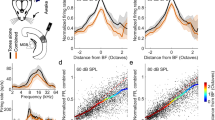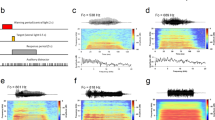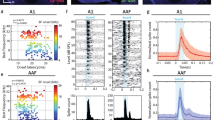Abstract
The corticofugal (descending) auditory system forms multiple feedback loops, and adjusts and improves auditory signal processing in the subcortical auditory nuclei. However, the mechanism by which the corticofugal system modulates cochlear hair cells has been unexplored. We found that electric stimulation of cortical neurons via the corticofugal system modulates cochlear hair cells in a highly specific way according to the relationship in terms of best frequency between cortical neurons and hair cells. Such frequency-specific effects can be explained by selective corticofugal modulation of individual olivocochlear efferent fibers.
This is a preview of subscription content, access via your institution
Access options
Subscribe to this journal
Receive 12 print issues and online access
$209.00 per year
only $17.42 per issue
Buy this article
- Purchase on Springer Link
- Instant access to full article PDF
Prices may be subject to local taxes which are calculated during checkout





Similar content being viewed by others
References
Huffman, R. F. & Henson O. W. Jr. The descending auditory pathway and acousticomotor systems: connections with the inferior colliculus. Brain Res. Rev. 15, 295–323 (1990).
Warr, W. B. in The Mammalian Auditory Pathway: Neuroanatomy (eds. Webster, D. B., Popper, A. N. & Fay, R. R.) 410–448 (Springer, New York, 1992).
Bishop, A. L. & Henson, O. W. Jr. The efferent cochlear projections of the superior olivary complex in the mustached bat. Hear Res. 31, 175–182 (1987).
Schnitzler, H. U. Echoortung bei der Fledermaus Chilonycteris rubiginosa. Z. Vergl. Physiol. 68, 25–38 (1970).
Henson, O. W. Jr., Henson, M. M., Kobler, J. B. & Pollack, G. D. in Animal Sonar Systems (eds. Busnel, R. G. & Fish, J. F.) 913–916 (Plenum, New York, 1980).
Gaioni, S. J., Riquimaroux, H. & Suga, N. Biosonar behavior of mustached bats swung on a pendulum prior to cortical ablation. J. Neurophysiol. 64, 1801–1817 (1990).
Goldman, L. J. & Henson, O. W. Jr. Prey recognition and selection by the constant frequency bat, Pteronotus P. parnellii. Beh. Ecol. Sociobiol. 2, 411–419 (1977).
Suga, N. & Jen, P. H. Further studies on the peripheral auditory system of 'CF-FM' bats specialized for fine frequency analysis of Doppler-shifted echoes. J. Exp. Biol. 69, 207–232 (1977).
Suga, N. & Manabe, T. Neural basis of amplitude-spectrum representation in auditory cortex of the mustached bat. J. Neurophysiol. 47, 225–255 (1982).
Yan, J. & Suga, N. Corticofugal modulation of time-domain processing of biosonar information in bats. Science 273, 1100–1103 (1996).
Zhang, Y., Suga, N. & Yan, J. Corticofugal modulation of frequency processing in bat auditory system. Nature 387, 900–903 (1997).
Zhang, Y. & Suga, N. Modulation of responses and frequency tuning of thalamic and collicular neurons by cortical activation in mustached bats. J. Neurophysiol. 84, 325–333 (2000).
Pollak, G., Henson, O. W. Jr. & Novick, A. Cochlear microphonic audiograms in the “pure tone” bat chilonycteris parnellii parnellii. Science 176, 66–68 (1972).
Xie, D. H. & Henson, O. W. Jr. Tonic efferent-induced cochlear damping in roosting and echolocating mustached bats. Hear. Res. 124, 60–68 (1998).
Suga, N., Gao, E., Zhang, Y., Ma, X. & Olsen, J. F. The corticofugal system for hearing: recent progress. Proc. Natl. Acad. Sci. USA 97, 11807–11814 (2000).
Suga, N. & Jen, P. H. Peripheral control of acoustic signals in the auditory system of echolocating bats. J. Exp. Biol. 62, 277–311 (1975).
Huffman, R. F. & Henson, O. W. Jr. Labile cochlear tuning in the mustached bat. I. Concomitant shifts in biosonar emission frequency. J. Comp. Physiol. A 171, 725–734 (1993).
Huffman, R. F. & Henson, O. W. Jr. Cochlear and CNS tonotopy: normal physiological shifts in the mustached bat. Hear. Res. 56, 79–85 (1991).
Manabe, T., Suga, N. & Ostwald, J. Aural representation in the Doppler-shifted-CF processing area of the auditory cortex of the mustache bat. Science 200, 339–342 (1978).
Liu, W. & Suga, N. Binaural and commissural organization of the primary auditory cortex of the mustached bat. J. Comp. Physiol. A 181, 599–605 (1997).
Desmedt, J. E. & Monaco, P. Mode of action of the efferent olivocochlear bundle in the inner ear. Nature 193, 1263–1268 (1961).
Mulders, W. H. & Robertson, D. Effects on cochlear responses of activation of descending pathways from the inferior colliculus. Hear. Res. 149, 11–23 (2000).
Ma, X. & Suga, N. Plasticity of bat's central auditory system evoked by focal electric stimulation of auditory and/or somatosensory cortices. J. Neurophysiol. 85, 1078–1087 (2001).
Gao, E. & Suga, N. Experience-dependent corticofugal adjustment of midbrain frequency map in bat auditory system. Proc. Natl. Acad. Sci. USA 95, 12663–12670 (1998).
Gao, E. & Suga, N. Experience-dependent plasticity in the auditory cortex and the inferior colliculus of bats: role of the corticofugal system. Proc. Natl. Acad. Sci. USA 97, 8081–8086 (2000).
Yan, W. & Suga, N. Corticofugal modulation of the midbrain frequency map in the bat auditory system. Nat. Neurosci. 1, 54–58 (1998).
Goldberg, R. L. & Henson, O. W. Jr. Changes in cochlear mechanics during vocalization: evidence for a phasic medial efferent effect. Hear. Res. 122, 71–81 (1998).
Khalfa, S. et al. Evidence of peripheral auditory activity modulation by the auditory cortex in humans. Neuroscience 104, 347–358 (2001).
Puel, J. L., Bonfils, P. & Pujol, R. Selective attention modifies the active micromechanical properties of the cochlea. Brain Res. 447, 380–383 (1988).
Maison, S., Micheyl, C. & Collet, L. Influence of focused auditory attention on cochlear activity in humans. Psychophysiology 38, 35–40 (2001).
Riquimaroux, H., Gaioni, S. J. & Suga, N. Cortical computational maps control auditory perception. Science 251, 565–568 (1991).
Zhang, Y. & Suga, N. Corticofugal amplification of subcortical responses to single tone stimuli in the mustached bat. J. Neurophysiol. 78, 3489–3492 (1997).
Henson, O. W. Jr., Pollak, G. D., Kobler, J. B., Henson, M. M. & Goldman, L. J. Cochlear microphonic potentials elicited by biosonar signals in flying bats, Pteronotus p. parnellii. Hear. Res. 7, 127–147 (1982).
Dewson, J. H. III. Efferent of olivocochlear bund. some relationships to stimulus discrimination in noise. J. Neurophysiol. 31, 122–130 (1968).
Nieder, P. & Nieder, I. Stimulation of efferent olivocochlear bundle causes release from low level masking. Nature 227, 184–185 (1970).
Dolan, D. F. & Nuttall, A. L. Masked cochlear whole-nerve response intensity functions altered by electrical stimulation of the crossed olivocochlear bundle. J. Acoust. Soc. Am. 83, 1081–1086 (1988).
Kawase, T., Delgutte, B. & Liberman, M. C. Antimasking effects of the olivocochlear reflex. II. Enhancement of auditory-nerve response to masked tones. J. Neurophysiol. 70, 2533–2549 (1993).
Geisler, C. D. Hypothesis on the function of the crossed olivocochlear bundle. J. Acoust. Soc. Am. 56, 1908–1909 (1974).
Oatman, L. C. & Anderson, B. W. Effects of visual attention on tone burst evoked auditory potentials. Exp. Neurol. 57, 200–211 (1977)
Wiederhold, M. L. Variations in the effects of electric stimulation of the crossed olivocochlear bundle on cat single auditory-nerve-fiber responses to tone bursts. J. Acoust. Soc. Am. 48, 966–977 (1970).
Mountain, D. C. Changes in endolymphatic potential and crossed olivocochlear bundle stimulation alter cochlear mechanics. Science 210, 71–72 (1980).
Siegel, J. H. & Kim, D. O. Efferent neural control of cochlear mechanics? Olivocochlear bundle stimulation affects cochlear biomechanical nonlinearity. Hear. Res. 6, 171–182 (1982).
Rajan, R. Electrical stimulation of the inferior colliculus at low rates protects the cochlea from auditory desensitization. Brain Res. 506, 192–204 (1990).
Henson, O. W. Jr. & Pollak, G. D. A technique for chronic implantation of electrodes in the cochleae of bats. Physiol. Behav. 8, 1185–1187 (1972).
Suga, N., Niwa, H., Taniguchi, I. & Margoliash, D. The personalized auditory cortex of the mustached bat: adaptation for echolocation. J. Neurophysiol. 58, 643–654 (1987).
Suga, N. & Tsuzuki, K. Inhibition and level-tolerant frequency tuning in the auditory cortex of the mustached bat. J. Neurophysiol. 53, 1109–1145 (1985).
Olsen, J. F. & Suga, N. Combination-sensitive neurons in the medial geniculate body of the mustached bat: encoding of target range information. J. Neurophysiol. 65, 1275–1296 (1991).
Acknowledgements
We thank O.W. Henson, S. Kuwada, N. Laleman and M.C. Liberman for their comments, the Ministry of Agriculture, Land and Marine Resources in Trinidad and Tobago for permitting us to collect the mustached bats, and F. Muradali for exporting them to the USA. This work was supported by a research grant from the National Institute on Deafness and Other Communicative Disorders (DC-00175).
Author information
Authors and Affiliations
Corresponding author
Rights and permissions
About this article
Cite this article
Xiao, Z., Suga, N. Modulation of cochlear hair cells by the auditory cortex in the mustached bat. Nat Neurosci 5, 57–63 (2002). https://doi.org/10.1038/nn786
Received:
Accepted:
Published:
Issue Date:
DOI: https://doi.org/10.1038/nn786
This article is cited by
-
Normal linear and non-linear cochlear mechanisms and efferent system functioning in individuals with misophonia
European Archives of Oto-Rhino-Laryngology (2024)
-
Cochlear activity in silent cue-target intervals shows a theta-rhythmic pattern and is correlated to attentional alpha and theta modulations
BMC Biology (2021)
-
The olivocochlear reflex strength in awake chinchillas is relevant for behavioural performance during visual selective attention with auditory distractors
Scientific Reports (2020)
-
Functional Interplay Between the Putative Measures of Rostral and Caudal Efferent Regulation of Speech Perception in Noise
Journal of the Association for Research in Otolaryngology (2017)
-
Cortical neurons of bats respond best to echoes from nearest targets when listening to natural biosonar multi-echo streams
Scientific Reports (2016)



